Genre: Shmup Developer: Vic Tokai Publisher: Vic Tokai Players: 1 Released: 1993
Sega of America made some questionable choices throughout the life span of the Genesis, most notable being the frequency with which it denied North American gamers some of the best games available on the system. Alien Soldier, Langrisser II, Monster World IV, Gleylancer, Surging Aura… the list goes on. Possibly the biggest slap to the face of North American Sega fans was denying them Battle Mania Daiginjou, aka Battle Mania 2 (henceforth referred to as BMD), which was released only in Japan and Korea.
North American gamers would know the first Battle Mania as Trouble Shooter, and though it was a fantastic game in 1991, the sequel took everything that was done well and improved upon it extensively. Sadly, very few people in North America had the chance to enjoy this game as it was deemed “too Japanese” for a North American audience. Those who went to the lengths of importing the game, unless fluent in Japanese, would’ve missed out on the story, so tragically this masterpiece was essentially unknown in the western hemisphere. All this changed with the dawn of the internet and rom hacking when MIJET released a fan translation patch that makes BMD playable in English! Psyched yet? You should be. This game is one of the best on the system. Just how great is that? Read on to find out!
Trouble Shooter was unique in its genre in that it featured two flying, jet-pack-powered anime girls (Madison and Crystal aka Mania and Maria in the Japanese version) instead of the typical lone spaceship as the protagonist. It was packed with amazing level art, quirky humour and fantastic gameplay mechanics. In BMD the two heroines are back, as are all the little details that made gameplay great. Cut scenes, gameplay dynamics, graphics, level design and sound have all been upgraded, and virtually nothing took a turn for the worse. It’s a tall order for a sequel to improve upon its predecessor without inadvertently ruining something, especially challenging if the predecessor was excellent to begin with. BMD does this masterfully.
Let’s start with the cut scenes: very important in a game that features two cute anime girls! While the cut scenes in Trouble Shooter were a little sterile and lifeless, BMD packs some really cool anime-style artwork in between levels. The character portraits are nicely detailed and change to reflect the characters’ moods. The artwork is well done and makes BMD feel like a high action anime. The frequent use of cut scenes between levels charges the game with an air of excitement and action, and pulls you right into the story, which, while not exactly intricate, is still more detailed than what you get in most shooters.
The dynamic of controlling both heroines during gameplay is back, as is the option to select your special weapon at the start of each level. The special weapons are a little more insane this time around. Case in point: the Chainsaw Beam – part laser, part chainsaw, all boss-murdering goodness. The other weapons are equally cool: the powerful Eraser Laser, the screen clearing Neo-Thunder and the epic Benten Bomb are all useful during different parts of the game, and admittedly it does require several playthrough sessions (or attempts) to figure out just which special weapon is best suited for what level. The special weapons need to be charged during gameplay, just like in the first game. Some frustration may result from accidentally trying to fire them when they’re not ready, causing you to reset the charge gauge. Fortunately, the charge fills quickly allowing for a satisfying amount of uses per level.
The controls are slick and responsive, and dare I say perfect? Yes I do; there really is no way the control mechanism could be improved. BMD features the option to choose three different modes of fire. You can keep the classic setup of one-way straightforward fire or select one of the new dynamics. Two-way fire allows you to turn around with the press of a button and fire behind you (not that useful since in one-way mode you can always turn Maria to fire behind you while Mania continues to shoot forward). However, the third option, eight-way fire, is fantastic! The ability to shoot in eight directions adds an unprecedented level of strategy and actually makes the game a lot easier. I’m pretty sure the game was programmed with this mode of play in mind. There are several levels (including the first one) that feature vertical scrolling where being able to shoot up or down is invaluable. Most bosses are also very mobile and the ability to shoot them from different angles makes the fights a lot more fair and fun. The eight-way fire cannot be praised enough. The idea may seem awkward at first but once you try it you’ll never go back to one-way fire again, and every other horizontal shooter will seem strangely lacking thereafter.
The graphics are standard 16-bit fare, but they are done very well, and there is virtually no slowdown anywhere in the game. A nice colour palette combined with expertly drawn backgrounds makes BMD pleasant to look at. For a SHMUP the sprites are large and detailed, especially when it comes to the enemies. Most of the foes you fight are the size of your typical boss in a lesser game in the genre. The actual bosses are big, creative, well-animated and intricately detailed with excellent use of the Genesis’ limited colour palette. In fact, colour is used so well that it almost makes you think the developers somehow found a secret way to increase the Genesis colour output. The only visual aspect that could stand to be better is the appearance of your characters’ standard fire. It hasn’t really changed much from the first game and doesn’t really change much throughout the adventure. Maria has red lasers, Mania has blue lasers, when you upgrade you just get more lasers… some variation in weapon power-ups would’ve been nice, but it’s not a huge deal compared to how great the special weapons look.
When it comes to level design, BMD really shines. Most SHMUPs just have you flying through empty space or sky, with the occasional cave/indoor level. BMD, on the other hand, actually utilizes aspects of the levels themselves to drive gameplay. While technically a horizontal shooter, BMD switches to vertical scrolling on several occasions, and while it’s technically possible to play these parts with one-way horizontal fire, you’ll really appreciate the eight-way fire feature here. Elements of most levels are very active and for the most part will try to kill you in elaborate ways. The vertically scrolling levels have especially active environments with features like bio-mechanical skulls that puke toxic garbage, robots that drill out of the walls and falling bombs that you need to utilize to clear a path for yourself. The unique art style of all these neat features really makes them stand out from the standard traps and enemies of other games.
The sound effects and music in BMD are a massive improvement over the audio in Trouble Shooter. The musical compositions feature robust drums and synth guitars and a surprising amount of bass. BMD is a prime example of just how awesome the Genesis’ FM chip can sound, and the audio programmers at Vic Tokai clearly knew what they were doing. There is a wonderful variety of tunes in the game, and the sound test in the options is full of nice touches like animated Maria chibis that rock out to the songs when you play them. It’s the plentiful details like this, that give BMD so much charm.
If this review seems a little long it’s because I believe in giving credit where credit is due, and BMD deserves a lot of it. It’s damn hard trying to find anything wrong with this game, and the only significant omission is the lack of two-player mode. Trouble Shooter was a fine single-player romp, and it would’ve been great to see that taken to the next level in the sequel. Sega did it with Sonic, Vic Tokai could’ve done it with Battle Mania. Given that game-play consists of controlling two characters, the lack of two-player mode is almost mind boggling. Other than that oversight there really is nothing wrong with this game. The MIJET translation is also a fantastic work of art in itself. It is without error and features the typical quirks like mild swearing that add to the fun of the game. Finding an official Japanese BMD will cost you between $150-$200, which is steep but worth it for a collector, though a repro will cost less. Either way though, if you consider yourself a Genesis player at all you owe it to yourself to play this game!
SCORE: 10 out of 10

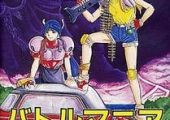
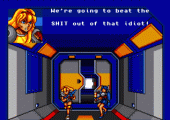
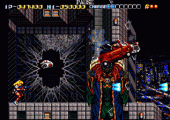
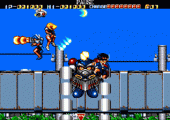
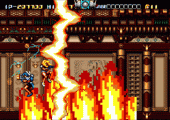
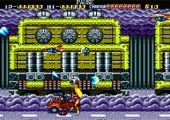
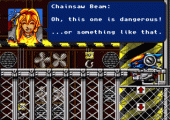
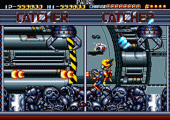
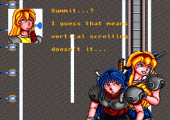
Even better than its predecessor. Simply addicting.
I honestly don’t think this game is that great. OK, it’s mostly better than the prequel, but it barely offers anything new, which I’d expect. I don’t like the colours very much and the music lacks catchiness. And I feel there is something missing, a big WOW!-inducing event now and then. There are many better shooters on the system. I’d only get this one after being done with most of them. Still, a solid 7 in my book
This game is simply incredible, and it is definitely worth paying the high asking price.